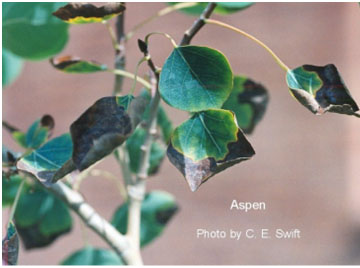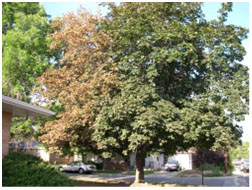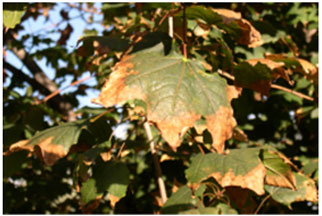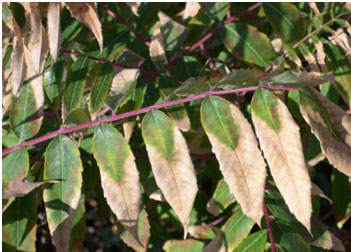by S. Rose and C.E. Swift * (12/14)
Revised by L. Langelo**
Quick Facts…
- Leaf scorch can appear as leaf spots or a burn along the margin of the leaf.
- Improper watering is the common cause of leaf scorch.
- Too much fertilizer can cause leaf spots and marginal burning.
- Scorched tree leaves can drop prematurely.
Introduction

Figure 1: Leaf scorch on aspen. |

Figure 2: Leaf scorch on one side of maple tree.
|

Figure 3: Close-up of scorched leaves. Photo by Carol O’Meara. |

Figure 4: Heat Stress on Euonymus. |

Figure 5: Scorch and needle loss on Colorado spruce due to root damage. Note the spiral of damage. This is due to the growth pattern of the tree. |

Figure 6: Leaf scorch of Rhus sp.
|
During the hot days of summer, many trees, shrubs, flowers and vegetables develop dry, brown leaf margins. The tissue between the main veins may also be affected causing leaf spots. In severe cases, entire leaves will turn brown or black and die. Some trees, such as aspens, are especially susceptible, but the condition may occur in many other species. Evergreens can also suffer leaf scorch in which the needle ends turn a light tan or pinkish color. If the condition persists, needles will turn brown or develop brown bands, and may drop off.
Both of these conditions are called leaf scorch, caused by a tree or shrub’s inability to take up sufficient water to meet its needs under harsh summer weather conditions. Water is taken up by a plant through its fine feeder roots and transported through the vascular system to the leaves. When it is unable to take up enough water, the leaf tissue that is farthest from the major veins will dehydrate first. That is why leaf margins scorch first (Figure 1).
Inadequate Roots. Most frequently, the problem is a root system inadequate to meet the plant’s needs. This may be due to: 1.) poor root growth due to being restricted by pavement as seen with the maple tree (Figure 2); 2.) root loss from tilling or construction; 3.) and application of a soil sterilant in the vicinity of the tree; 4.) drought stress; 5.) a loss of roots due to dehydration during a dry winter and spring; 6.) overirrigation or over-application of a fertilizer; and 7.) an injury or infection on the trunk or branches severe enough to interfere with the movement of water and nutrients.
- Excess Moisture. When a plant is over watered, it cannot grow new, waterabsorbing roots without oxygen. Soggy soils therefore prohibit root development and scorch will result. The combination of no soil moisture in the winter and spring, and too frequent watering in the summer will practically guarantee that leaf scorch will develop.
- Too Much Fertilizer. The overapplication of fertilizer can cause leaf scorch by ‘burning’ the roots. This damage may appear as either leaf spots or marginal leaf burns. The damage may show up on one sector of the plant, one limb of a tree or shrub, or the entire plant, depending on how much of the root system is damaged by fertilizer. Fertilizers are salts and soils with a salt level higher than the plant will also cause leaf scorch. Fertilizer spikes, that deliver concentrated salts at specific sites, can burn roots and contribute to leaf scorch.
Related Stress Symptoms
Heat Stress may cause results varying from wilt to discolored leaves to severe desiccation and cell death, depending on the severity of the stress. Plants suffering from heat stress shut down basic growth functions and cannot draw sufficient water up into their leaves. Thus, this type of stress is considered to be related to drought stress. Heat injury can cause damage to young plants at the soil line, resulting in collapse. Plants on the south or west sides of buildings or fences may show the effects of reflected, concentrated heat, as may plants surrounded by rock mulch. Black plastic mulch can cause the soil to heat up to levels beyond a plant’s tolerance, shutting down growth processes and severely damaging roots resulting in leaf scorch.
Cladoptosis (or Kladoptosis) is the dropping of leaves or twigs under conditions of stress. Ethylene gas, stimulated by drought or other stress conditions, causes a separation layer to form at the base of leaves or twigs. This is a defense mechanism of the plant, which sheds tissue to preserve the life of the entire plant. The leaves may turn yellow before dropping, mimicking fall conditions. Many deciduous species will drop leaves under stress, but the condition is most commonly seen in aspens, cottonwoods, and willows. Over watering, under watering, excessive heat, or root damage may all cause leaves to drop. Girdling roots, which often result from improper planting depth, also can cause premature leaf drop.
Prevention
Once leaf scorch has occurred, there is no cure. The dehydrated portions of the leaf will not turn green again, but with proper water management, the plant may recover.
Prevention of scorch needs to begin with winter watering. A deep soaking once a month, when there is no snow cover, will help prevent root die-back due to dehydration. The roots of mature trees extend outward several times the height of the tree, and this entire area needs water. To water in winter, choose a day when the air temperature is above freezing and water early enough in the day for the water to soak in before the nighttime freeze. Water that freezes on the surface will cause root suffocation and make the problem worse.
During the growing season, water deeply and as infrequently as possible. This can be difficult when trees are located in or near lawns, but a deep and infrequent watering schedule will benefit your lawn as well, encouraging deep root development. Trees typically need less frequent irrigation than lawns do, but the two can coexist. Remember that roots need oxygen, and this means the soil must be allowed to dry out somewhat between watering.
Finally, if scorch occurs, resist the urge to continually apply more water. Just keep up with the deep and infrequent schedule. In some years, if conditions are especially hot and windy, some scorch is likely. Don’t panic and kill off your trees with an excess of kindness by over watering.
References
Fosket, D. E. 1994. Plant Growth and Development. Academic Press, San Diego, CA.
Gresshoff, P. M., ed. 1993. Plant Responses to the Environment. CRC Press, Boca Raton, FL.
Maloy, O. C. and Murray, T. D., eds. 2001. Encyclopedia of Plant Pathology. John Wiley and Sons, Inc., New York, NY.
Pirone, P. P. 1970. Diseases and Pests of Ornamental Plants. Ronald Press Co., New York, NY.
Sinclair, W. A., Lyon, H. H., and Johnson, W. T. 1987. Diseases of Trees and Shrubs. Cornell University Press, Ithaca, NY.
Additional Information
See the following fact sheets:
- Fall and Winter Watering, Colorado State University Extension Fact Sheet no. 7.211
- Tree Planting Steps, Colorado State University Colorado Master Gardener Publication no. 636
- Magnesium Chloride Toxicity in Plants, Colorado State University Extension Fact Sheet no. 7.425
*S. Rose, horticulture educator; C.E. Swift, former horticulture agent, Colorado State University Extension Tri River Area. **L. Langelo, Colorado State University Extension horticulture agent, Golden Plains Area. 8/09. Revised 12/14.
Colorado State University, U.S. Department of Agriculture, and Colorado counties cooperating. CSU Extension programs are available to all without discrimination. No endorsement of products mentioned is intended nor is criticism implied of products not mentioned.
Go to top of this page.





